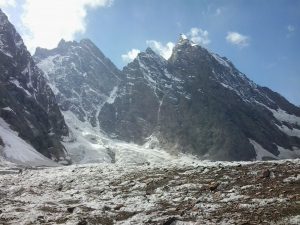“I cannot even take a deep breath anymore,” Ismail Bhatt coughed. “It is these years spent trying to keep warm with a kangri. It has shrivelled up my lungs.”
A kangri is an earthen pot filled with glowing coal, often used beneath clothing to keep people warm during winter in the high Himalayas. Doctors in Srinagar, the capital of Kashmir in northern India, say that indoor air pollution is the most common cause of tuberculosis in the region.
“My eyes water every time I go into the kitchen,” Sharda Sharma said. “You can see there is no chimney and we have to burn twigs because we cannot afford to buy kerosene. We are not high up in the Himalayas here in Dehradun, but the winters are still very cold. Then the fire is on almost throughout the night, and everyone keeps coughing.”
“It rains a lot here and then everything gets damp and cold,” said Namita Basnett, resident of Gangtok in Sikkim state. “So we have to have the fire on and close all windows. I know the gas coming from the flames is not good for the children, but what can I do?”
Black carbon, the soot particles emitted when wood or charcoal is burnt for cooking or heating, has long been an air-pollution concern in the Himalayas due to its impacts on human health. But scientists now say that in the last few decades black carbon has become a major contributor to global climate change, though opinion is divided on the extent of the effect.
One of the world’s leading black carbon researchers, Veerabhadran Ramanathan of the Scripps Institute of Oceanography, told the US Senate in 2010 that the effect of these particles on global warming ranged between 20% and 60% of the effect of carbon dioxide, the main greenhouse gas causing climate change. Asked about this again early this year, Ramanathan told thethirdpole.net, “I tend to the higher end of that range.”
Black carbon affects the climate by intercepting and absorbing sunlight and darkens snow and ice when deposited, hastening surface melt, while influencing cloud formation. The pollutant only stays in the atmosphere for less than a week, and so does not spread evenly through the atmosphere. Its climate and health impacts therefore have strong local and regional characteristics. In the high valleys of the Himalayas, black-carbon levels can now be as high as in a medium-sized city.
Major sources of black carbon include exhaust from diesel engines, household fuels like wood and coal, burned with traditional technologies, and open burning in forest and savannah. Asia accounts for almost half the world’s black-carbon emissions, according to a 2010 study by Princeton University scientists. And “emissions from northern India and central China contribute the majority of black carbon to the Himalayas, although the precise location varies with season,” says the study.
Black carbon is one of the major so-called “short–lived climate forcers,” along with tropospheric ozone and methane. These pollutants add to climate change, which is already affecting farm production worldwide, upping the frequency and severity of droughts, floods and storms, and raising sea levels. Slowing down near-term warming would reduce the intensity of these impacts and provide more time for humans to adapt to climate change.
A new assessment released by the UN Environment Programme (UNEP) shows that a small number of emission-reduction measures targeting black carbon and methane could immediately begin to protect the global climate and public health: “reducing them will provide significant benefits through improved air quality and a slowing of near-term climate change. The ‘win-win’ benefits for climate and public health have been overlooked in the wider climate change and air-quality debate.”
An international team of more than 50 researchers chaired by Drew Shindell of the National Aeronautics and Space Administration (NASA) has identified 16 measures for reducing these short-lived climate emissions. If implemented, it is believed these measures will reduce global black-carbon emissions by 77% and methane emissions by 38%. They will also prevent 2.4 million premature deaths annually from outdoor air pollution by 2030 and greatly reduce health impacts from indoor exposure. Due to the very high concentration of particulate-matter in Asia, especially in cold places like the Himalayas, reducing black carbon could prevent an even greater number of premature deaths in this region than elsewhere.
“There are clear and concrete measures that can be undertaken to help protect the global climate in the short to medium term,” said Shindell. The measures include use of clean-burning stoves for residential cooking; diesel particulate filters for vehicles; and banning open burning of agricultural waste. Other measures aim to address the problem of methane pollution. If fully implemented by 2030, these measures are estimated to reduce global warming 2050 by about 0.4 degrees Celsius by 2050, nearly halving the pace of global warming.
But since pollutants like black carbon have a short atmospheric lifetime, their removal only has a relatively small effect on long-term global warming. And so this must be seen as a strategy that complements but does not replace carbon dioxide reduction measures.
Current levels of black carbon and other particles in the atmosphere have disrupted regional weather patterns including the South Asian monsoon. If these emissions are significantly reduced in this region, it is possible that weather patterns could return to a less disturbed state. Reducing black-carbon emissions would also reduce the amount of these particles deposited on snow and ice surfaces in the Himalayas and other mountain areas, which is suspected of contributing to the accelerated melting of glaciers. There are also huge economic gains associated with reduced health, climate, crop yields and ecosystem impacts.
Measures to reduce black carbon and other short-lived pollutants have already been adopted, but much wider and more rapid implementation is required. Coordinated regional action is important to effectively address certain key impacts, for instance on the Arctic, Himalayas and South Asian Monsoon. Short-lived climate forcers cross national borders and impact neighbouring countries.
Of course, attempts to reduce black-carbon emissions face a number of barriers. The predominance of small and mobile emissions sources create challenges related to monitoring, funding, institutional capacity and coordination. There have been many initiatives in China and South Asia to shift to other sources of cooking fuel or to improve the efficiency of stoves, but the size of the problem has defied an overall solution. Attempts to reduce diesel pollution have been overtaken by the rise in number of diesel engines. According to the Princeton University study, black carbon emissions from vehicles in India increased by over 100% in the 1990s. Current tax schemes ensure that the price of diesel is 60% of that of petrol, as the New Delhi-based think-tank Centre for Science and Environment has pointed out.
Emissions from biofuel burning by individual households made up about 11% of total global black-carbon emissions in 1996. Of that total, about 35% came from India and 39% came from China. Although the Indian government and NGOs distributed some 90 million improved cooking stoves between 1983 and 2002, this programme failed to meet its primary objective of improving fuel efficiency, as well as its secondary objectives of saving user time and avoiding deforestation. In contrast, the Chinese National Improved Stove Programme, which ran from 1983 to 1996, was hugely successful both in terms of improving energy efficiency and stimulating rural development. During this time, the Chinese government deployed 120 million improved stoves, which an estimated seven out of every 10 households dependent on biofuel for cooking began to use.
“History indicates that black-carbon emissions can and will be reduced as development occurs. However, this transition can be accelerated,” asserts the Princeton University study. “There are now clear, powerful, abundant and compelling reasons to reduce levels of pollutants such as black carbon and tropospheric ozone along with methane: their growing contribution to climate change being just one of them,” added Achim Steiner, executive director of UNEP.
Such thinking has led to recent attempts to revive the battle against short-lived climate forcers. In February 2012, US Secretary of State Hillary Clinton announced the launch of the Climate and Clean Air Coalition. Clinton said this organisation would strengthen the Global Alliance for Clean Cookstoves, which launched in 2010 and has released a roadmap for the universal adoption of cleancook stoves and fuels. China joined the alliance this month.
But Bhatt, Sharma, Basnett and thousands of others in the Himalayas are still waiting for the impacts of such initiatives to reach their homes. Meanwhile, they are dying, and the world’s climate is increasingly at risk.
Joydeep Gupta is south Asia director of the third pole project.

